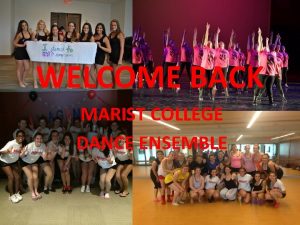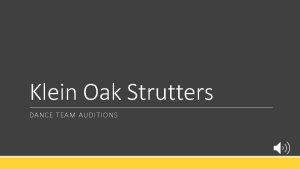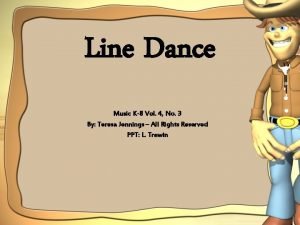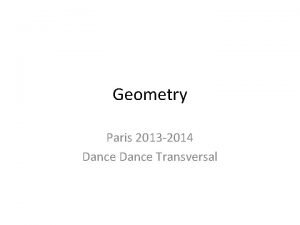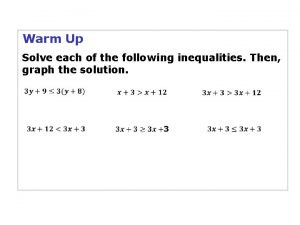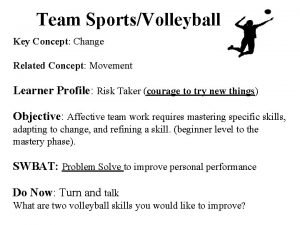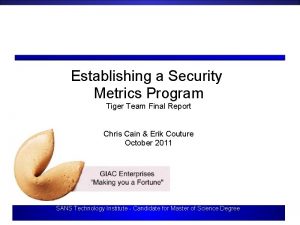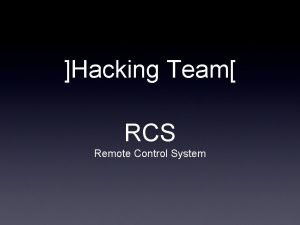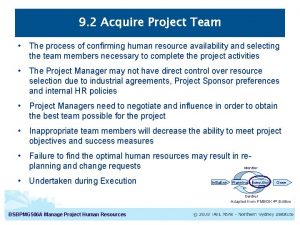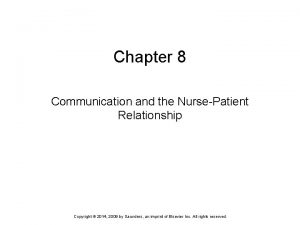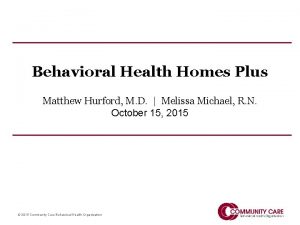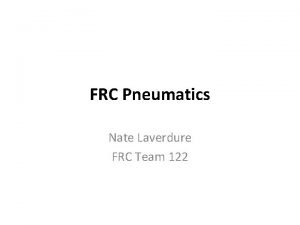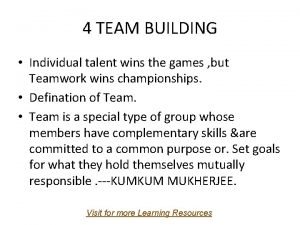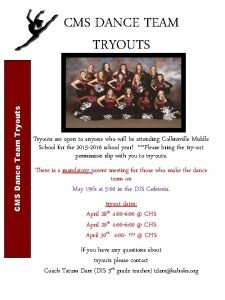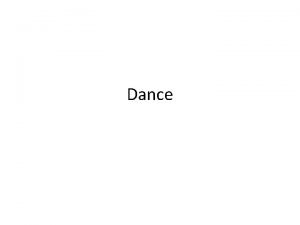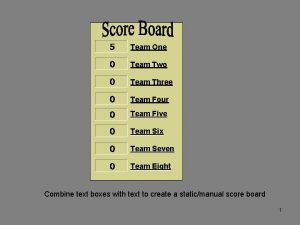DANCE DANCE JEOPARDY DANCE Jeopardy is a team































- Slides: 31

DANCE

DANCE JEOPARDY • DANCE Jeopardy is a team based quiz best suited to groups of 3 or more individuals • This quiz reviews DANCE behaviors and coding strategies • Follow the instructions on the next two slides to get started

DANCE JEOPARDY • The DANCE Jeopardy quiz consists of 5 columns. • The first 4 columns correspond to the DANCE dimensions: – Let’s DANCE = Emotional Quality – Glance at the DANCE = Sensitivity & Responsivity – DANCING Queen = Support of Behavioral & Emotional Regulation – Have you DANCE’d lately = Promotion of Developmental Growth • The last column Fresh Eyes every time = Coding tips

INSTRUCTIONS 1. Click on the Slide Show tab 2. Then click on the second tab from the left From Current Slide 3. Start on the next slide (#6) which has the Jeopardy board 4. Based on individuals’ selections, clink on the box from the corresponding category and point value 5. This will take you to the question and answer slide. Click the Right or Down arrow to bring up the question and then the same arrow when you are ready for the answer

INSTRUCTIONS 6. When you are finished with the question, click on the colored arrow in the bottom left corner of the slide and it will take you back to the game board. 7. If you are keeping score, you will have to do so on your own. As there is not a scoring mechanism in this quiz. Click the Down or Right Arrow to move to the game board

Let’s DANCE Glance at the DANCE DANCING Queen Have you DANCE’d lately? Fresh Eyes every time 100 100 100 200 200 200 300 300 300 400 400 400 500 500 500

Let’s DANCE – 100 Points QUESTION: • The behavior that considers negative comments to others about the child. ANSWER: • Negative Comments About the Child to Others

Let’s DANCE – 200 Points QUESTION: • The behavior that requires the observation of just the caregiver’s facial expressions, body language, and tone of voice. ANSWER: • Expressed Positive Affect

Let’s DANCE – 300 Points QUESTION: • The behavior that observes the tone and content of the caregiver’s words and sounds to the child. ANSWER: • Verbal Quality

Let’s DANCE – 400 Points QUESTION: • The behavior concerned with the caregiver’s affect relative to the child’s affect. ANSWER: • Caregiver’s Affect Complements Child’s Affect

Let’s DANCE – 500 Points QUESTION: • The behavior you would code is the child is fussy for 15 seconds. ANSWER: • Response to Distress

Glance at the DANCE – 100 Points QUESTION: • The behavior that includes the caregiver’s visual attention oriented to the child or shared focus of interest. ANSWER: • Visual Engagement

Glance at the DANCE – 200 Points QUESTION: • The only behavior in the Sensitivity and Responsivity Dimension that is coded as a frequency (number of occurrences). ANSWER: • Negative Touch

Glance at the DANCE – 300 Points QUESTION: • This behavior requires observation of the tempo of the caregiver’s responses relative to the child’s expressed needs. ANSWER: • Pacing

Glance at the DANCE – 400 Points QUESTION: • This behavior includes the caregiver not imposing her own agenda unless it is for the health, safety, or regulation of the child. ANSWER: • Non-Intrusiveness

Glance at the DANCE – 500 Points QUESTION: • The behavior that considers the caregiver’s responses as timely and sensitive; support of the child’s needs. ANSWER: • Responsiveness

DANCING Queen – 100 Points QUESTION: • The behavior that considers the harm of others including pets. ANSWER: • Limit Setting

DANCING Queen – 200 Points QUESTION: • This behavior has a coding option of not observable (N/A) only when observing a video taped interaction. ANSWER: • Completes Interactions

DANCING Queen – 300 Points QUESTION: • The behavior that observes providing closure to an interaction, actively supporting transition. ANSWER: • Completes Interaction

DANCING Queen – 400 Points QUESTION: • This behavior may have fewer opportunities to code with very young infants. ANSWER: • Limit Setting

DANCING Queen – 500 Points QUESTION: • This behavior is considers damage to property, harm to others, and safety of the child. ANSWER: • Limit Setting

Have you DANCED lately? – 100 Points QUESTION: • This behavior considers the number of criticisms, accusations, threats, and name-calling of the child to the child. ANSWER: • Negative Verbal Content

Have you DANCED lately? – 200 Points QUESTION: • This behavior captures the number of times the caregiver genuinely compliments the child. ANSWER: • Praise

Have you DANCED lately? – 300 Points QUESTION: • This behavior considers the quality and quantity of the caregiver’s communications to the child. ANSWER: • Verbal Connectedness

Have you DANCED lately? – 400 Points QUESTION: • The behavior that considers the caregiver attempts to provide support to promote success beyond what the child is able to do on his/her own. ANSWER: • Scaffolding

Have you DANCED lately? – 500 Points QUESTION: • This behavior considers the safety of the child, appropriateness of materials and resources, caregiver avoids interfering, and caregiver offering support when needed. ANSWER: • Supports Exploration

Fresh Eyes every time – 100 Points QUESTION: • What code do you fill-in or circle if a behavior is not observable? ANSWER: • N/A

Fresh Eyes every time – 200 Points QUESTION: • What is the range of possible numbers when coding DANCE behaviors that are coded as a frequency? ANSWER: • 0 -3

Fresh Eyes every time – 300 Points QUESTION: • What is the range of possible numbers when coding DANCE behaviors that are coded as a percentage? ANSWER: • 0 -100%

Fresh Eyes every time – 400 Points QUESTION: • What words help to determine and justify DANCE codes? ANSWER: • Frequency, Intensity, and Duration words

Fresh Eyes every time – 500 Points QUESTION: • Name three words that capture the varied duration of caregiver and child behaviors. ANSWER: • Short or Fleeting or Brief • Moderate • Prolonged or Extensive
 Dance dance dance in the freedom we know
Dance dance dance in the freedom we know The white team cheers for the blue team, just like
The white team cheers for the blue team, just like Going native project management
Going native project management Team spirit becomes team infatuation
Team spirit becomes team infatuation Heritage high school cheer
Heritage high school cheer Marist college dance team
Marist college dance team Marist foxmail
Marist foxmail Uwm dance team
Uwm dance team Ko strutters
Ko strutters Is dancing a hobby
Is dancing a hobby Everybody dance and sing line dance
Everybody dance and sing line dance Geometry bell ringers
Geometry bell ringers Inequalities warm up
Inequalities warm up Line dance originated to a song in 2007
Line dance originated to a song in 2007 Dance jeopardy
Dance jeopardy Erider team oregon
Erider team oregon Net touched by a player in volleyball hand signal
Net touched by a player in volleyball hand signal Tiger team security
Tiger team security Hacking team rcs
Hacking team rcs Vector control team
Vector control team Acquire project team
Acquire project team Hpd mental health division
Hpd mental health division Project core team roles and responsibilities
Project core team roles and responsibilities School-based financial management deped
School-based financial management deped Chapter 8 health team communication
Chapter 8 health team communication Cross functional team ppt
Cross functional team ppt Home team cast
Home team cast Teamwork poem figure of speech
Teamwork poem figure of speech Team 122
Team 122 Oregon motorcycle training
Oregon motorcycle training Difference between a team and a group
Difference between a team and a group Testing team structure
Testing team structure





